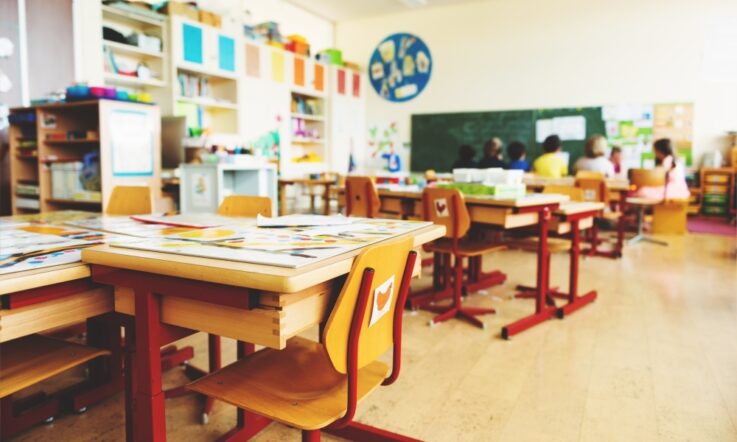There can be little argument that everyone working in schools should be aware that exposure to traumatic events is relatively common (Haslam et al., 2023) and that such exposure may lead to academic and social-emotional difficulties.
Undoubtedly, teachers need to understand the impact that traumatic experiences can have on student learning, behaviour, and wellbeing (Felitti et al., 1998).
Exposure to trauma in childhood, known as developmental trauma, may even alter the structure of the brain, making it more difficult for some children to learn, interact positively with others, or cope with routine setbacks and challenges (Center on the Developing Child, 2007).
It is therefore critical that teachers understand that difficulty with learning or retaining information, poor decision-making, or difficulties getting on with others may be understood as repercussions of negative events or experiences such as domestic violence, neglect, or bullying. They also need to understand the effects of trauma on brain development and functioning as it can inform how they relate to students and the ways they provide instruction.
But do teachers need to be trained therapists? A resounding no. Teachers can provide the best support to students impacted by trauma by developing positive relationships, implementing evidence-informed classroom practices (AITSL, 2021), providing effective instruction and managing the classroom environment so that all students, including those affected by trauma, can thrive.
Accessing therapeutic support
Some students impacted by trauma will need therapeutic support. Schools therefore need systems to identify and refer those students needing more intensive support. Effective systems include the establishment of student support teams, the development of identification pathways and clear referral criteria, and partnerships with internal and external support services (Weist et al., 2022).
Student support teams include classroom teachers, family members, and related support personnel (Nese et al., 2021). Teams collaborate with the student, families and wellbeing professionals to select, access and monitor appropriate interventions. Identification pathways include use of existing school data, universal screening and direct teacher referral. Teams collect this information, assess student support needs and develop individual student plans. Plans draw together all the support provided to students, outline roles and responsibilities, clearly delineate the role of teachers and describe the supports provided by other personnel.
Ongoing and active collaboration between school staff and wellbeing professionals has been shown to yield better outcomes for students than an isolated approach where wellbeing professionals or external agencies work alongside, rather than with, schools (Weist et al., 2022). An integrated approach to student support involves school staff and wellbeing professionals working together, ensuring that the support provided by professionals is not seen as separate to the work done by schools and which acknowledges the important role of teachers in providing students with a safe, predictable and supportive environment.
Do students affected by trauma need special consideration? Of course. All students need to have their individual circumstances considered. Such considerations include awareness of disability, cultural background and social-emotional needs, including stress caused by traumatic experiences and events. A supportive approach to students affected by trauma contains the same ingredients as effective support for all students.
The tools already at schools’ disposal
When we build positive relationships with students, getting to know them as individuals and learning about their strengths and challenges, this provides the foundation for a non-judgmental and inclusive response when students struggle to engage productively at school.
The starting point for effective trauma-informed support is the belief that all students belong and can grow and learn. It’s important for schools to share a common ethos and understanding about the need for a positive approach to behaviour support. When schools see discipline as about teaching rather than about punishing, teachers are given the permission to let go of trying to control student behaviour and instead look at the reasons underlying the way that individuals behave.
The good news is that schools already have at their disposal the tools to develop positive and supportive learning environments where all students can experience a sense of belonging.
- We know that establishing expectations and routines provides all students with a sense of safety and predictability (CESE, 2020).
- We know that providing students with specific feedback about what they are doing well contributes to improved wellbeing for both teachers and students (Ennis et al., 2018).
- We also know that differentiated instruction that recognises where students start and incrementally moves them forward, increases student engagement and improves learning (Pozas et al., 2021; Smale-Jacobse et al., 2019).
- And, importantly, we know that responding to behaviour instructionally and with consideration of the reasons behind the behaviour is way more effective than exclusionary or punitive responses which involve shaming students or removing them from the learning environment (Wang, Scanlon & Del Toro, 2023).
References
Australian Institute for Teaching and School Leadership (AITSL). (2021). Classroom Management: Standards-aligned evidence-based approaches. https://www.aitsl.edu.au/research/spotlights/classroom-management-standards-aligned-evidence-based-approaches
Center on the Developing Child. (2007). The impact of early adversity on children’s development. https://developingchild.harvard.edu/resources/inbrief-the-impact-of-early-adversity-on-childrens-development/
Centre for Education Statistics and Evaluation (CESE). (2020). Classroom management: Creating and maintaining positive learning environments. https://education.nsw.gov.au/about-us/educational-data/cese/publications/literature-reviews/classroom-management
Ennis, R. P., Royer, D. J., Lane, K. L., Menzies, H. M., Oakes, W. P., & Schellman, L. E. (2018). Behavior-Specific Praise: An Effective, Efficient, Low-Intensity Strategy to Support Student Success. Beyond Behavior, 27(3), 134–139. https://doi.org/10.1177/1074295618798587
Felitti, V. J., Anda, R. F., Nordenberg, D., Williamson, D. F., Spitz, A. M., Edwards, V., & Marks, J. S. (1998). Relationship of childhood abuse and household dysfunction to many of the leading causes of death in adults: The Adverse Childhood Experiences (ACE) Study. American Journal of Preventive Medicine, 14(4), 245-258. https://doi.org/10.1016/S0749-3797(98)00017-8
Haslam, D., Mathews, B., Pacella, R., Scott, J. G., Finkelhor, D., Higgins, D. J., Meinck, F., Erskine, H. E., Thomas, H. J., Lawrence, D., Malacova, E. (2023). The prevalence and impact of child maltreatment in Australia: Findings from the Australian Child Maltreatment Study: Brief report. Australian Child Maltreatment Study, Queensland University of Technology. https://www.acms.au/resources/the-prevalence-and-impact-of-child-maltreatment-in-australia-findings-from-the-australian-child-maltreatment-study-2023-brief-report/
Nese, R. N., Kittelman, A., Strickland-Cohen, M. K., & McIntosh, K. (2023). Examining teaming and Tier 2 and 3 practices within a PBIS framework. Journal of Positive Behavior Interventions, 25(1), 16-27. https://journals.sagepub.com/d...
Pozas, M., Letzel, V., Lindner, K. T., & Schwab, S. (2021). DI (Differentiated Instruction) does matter: The effects of DI on secondary school students’ well-being, social inclusion and academic self-concept. Frontiers in Education, 6. https://doi.org/10.3389/feduc.2021.729027
Smale-Jacobse, A. E., Meijer, A., Helms-Lorenz, M., & Maulana, R. (2019). Differentiated instruction in secondary education: A systematic review of research evidence. Frontiers in psychology, 10, 23-66. https://doi.org/10.3389/fpsyg.2019.02366
Wang, M. T., Scanlon, C. L., & Del Toro, J. (2023). Does anyone benefit from exclusionary discipline? An exploration on the direct and vicarious links between suspensions for minor infraction and adolescents’ academic achievement. American Psychologist, 78(1), 20-35. https://doi.org/10.1037/amp0001030
Weist, M. D., Splett, J. W., Halliday, C. A., Gage, N. A., Seaman, M. A., Perkins, K. A., ... & Distefano, C. (2022). A randomized controlled trial on the interconnected systems framework for school mental health and PBIS: Focus on proximal variables and school discipline. Journal of school psychology, 94, 49-65. https://pubmed.ncbi.nlm.nih.gov/36064215/
As a school leader consider the following: What systems do you have in place to identify and refer students who need therapeutic support? Are all staff aware of these identification pathways, and the referral criteria? Thinking about your own student support mechanisms – would you describe it as an integrated approach? Do school staff and external professionals work together to provide a supportive environment or is it seen as ‘separate’ to the work done at school?



